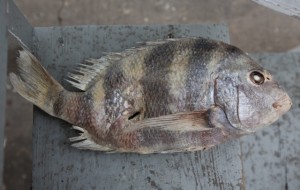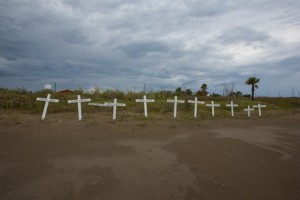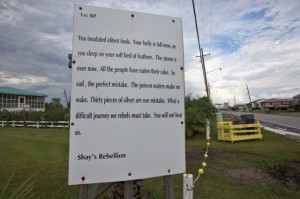By Xerxes Wilson
Staff Writer
Published: Saturday, September 28, 2013 at 6:01 a.m.
Oil spill cleanup workers could be at risk for developing liver and blood disorders, according to new research published in the American Journal of Medicine. The study, conducted by the University Cancer and Diagnostic Centers in Houston, found that participants exposed to oil had altered blood profiles and liver enzymes, and other symptoms compared to an unexposed group.
In the months following the 2010 Deepwater Horizon Oil Spill in the Gulf, BP hired a small army of locals and others to help deploy protective measures and gather oil that has spewed from the runaway well. Since some research has linked exposure to oil to health issues, more long-term research of the issue is underway. The study estimates that more than 170,000 workers contributed to cleanup efforts.
This latest research looked specifically at the link between oil exposure and blood and liver functions in people who had participated in the cleanup, said Mark D’Andrea, lead investigator for the University Cancer and Diagnostic Centers.
The center compared 117 people who had been exposed to the oil and dispersants used in the aftermath with a control group at least 100 miles away from Louisiana’s coast. Their various blood and liver functions, plus other benchmarks, were tested.
“Oil and secondary products are easily absorbed and can produce damage,” D’Andrea said, especially with people’s bone marrow, livers and kidneys.
The research found there were no significant changes in white blood cell counts. But platelet counts, blood urea nitrogen and creatinine levels were “substantially lower” in the exposed groups. The study also found other indicators of liver damage by comparing other biochemical benchmarks, D’Andrea said. “Phosphatases, amino transferases and dehydrogenases play critical roles in biological processes. These enzymes are involved in detoxification, metabolism and biosynthesis of energetic macromolecules that are important for different essential functions,” D’Andrea said. “Alterations in the levels of these enzymes result in biochemical impairment and lesions in the tissue and cellular function.”
In the months following the spill, much was made about the potential health problems the nearly 2 million gallons of dispersants such as Corexit spread in the aftermath to break down the oil. Corexit is banned in the United Kingdom because of potential risk to cleanup workers.
A series of interviews by the Government Accountability Project released earlier this year noted those involved in cleanup reported health problems such as kidney and liver damage, heart palpitations, bloody urine and memory loss. The report also took issue with the method and monitoring conducted by BP in its use of dispersants. At least some of the symptoms are shared with subjects of D’Andrea’s research. Those participants also reported headaches most frequently, followed by shortness of breath, skin rash, cough, dizzy spells, fatigue, painful joints, night sweats and chest pain.
D’Andrea said the research doesn’t specifically hinge on exposure to dispersants because some participants claimed they were heavily exposed to them and others noted they had little to no contact with the compounds. “The results of this study indicate that oil spill exposure appears to play a role in the development of hematologic and hepatic toxicity. However, additional long-term follow-up studies are required to understand the clinical significance of the oil spill exposure,” the study says.
The findings, like much of the research tied to the spill, are limited by a lack of pre-spill data for comparison, the report notes. Conclusions are also limited by the short-term snapshot nature of the project. “If they haven’t been screened they need to do some screening. Some we saw right after the screening and the others were perhaps years later. It will probably be a lifelong following. Who knows when that incident will cause an aberration in the DNA?” D’Andrea said.
A long-term study into the potential effects of oil and dispersant exposure is being conducted by the National Institute of Environmental Health Sciences. That organization has recruited more than 33,000 people who had some connection with the oil spill cleanup. “We actually know very little about very little exposures to oil, such as what someone who would have experience in cleanup would see,” said Dale Sandler, the study’s chief of epidemiology and principal investigator. “So it is important that we invest in this and do it right.”
Sandler said researchers are trying to create a systematic examination over about a decade to yield results that can accurately depict exposure risk and can be used to characterize risk in other oil exposure situations.
But coming up with such thorough and accurate results takes time. Participants in the study will be observed in different ways over different periods of time. Some will be part of phone interviews. Others have participated in in-home visits, and about 4,000 people will take part in a more rigorous clinical examination. Results will be released through the course of the research, Sandler said.
____________________________________________________
Home
Conservation Organizations Demand BP Accountability for Gulf Oil Disaster
September 27, 2013 | Posted by Elizabeth Skree in BP Oil Disaster, Media Resources
FOR IMMEDIATE RELEASE
Contact: Elizabeth Skree, Environmental Defense Fund, 202.553.2543, eskree@edf.org
Erin Greeson, National Audubon Society, 503.913.8978, egreeson@audubon.org
Emily Guidry Schatzel, National Wildlife Federation, 225.253.9781, schatzele@nwf.org
Conservation Organizations Demand BP Accountability for Gulf Oil Disaster
Deepwater Horizon civil trial resumes, groups reinforce need to restore
(New Orleans, LA-Sept. 27, 2013) On Monday, Sept. 30, phase II of the Deepwater Horizon civil trial will begin to determine how much BP will be required to pay in fines for the biggest oil spill in U.S. history. Today, leading national and local conservation organizations Environmental Defense Fund, National Wildlife Federation, National Audubon Society and the Lake Pontchartrain Basin Foundation released the following statement:
“Nearly three and a half years since the Deepwater Horizon rig explosion killed 11 men and caused the largest environmental disaster in U.S. history, the Gulf still waits for restoration. BP’s misleading advertising campaigns omit truths and facts: Gulf Coast communities, wildlife and ecosystems are still harmed and need to be restored. Tar mats continue to surface, miles of Louisiana shoreline remain oiled and the full effects of the oil spill may not be known for years to come.
“It is time for BP to accept full responsibility for the Gulf oil disaster. The natural resources of the Gulf, which sustain and bolster regional and national economies, need restoration now. We cannot wait any longer for our ruined wetlands and barrier islands to be restored.
“Restoration cannot begin in earnest until BP is brought to justice. The company has not paid a penny in Clean Water Act civil fines, which it owes for the millions of barrels of oil it spilled into the Gulf. These fines will be the primary funding for Gulf restoration projects under the RESTORE Act.
“A portion of the RESTORE Act funding, overseen by the Gulf Coast Ecosystem Restoration Council, will be spent on large-scale ecosystem restoration projects. The Mississippi River Delta region was among the hardest hit by the oil disaster and is essential to regional and national economies, including navigation, energy and seafood. The delta is invaluable to our communities and our environment; it provides vital habitat for hundreds of species of wildlife and birds along the Mississippi and Central Flyways, world-class fresh- and saltwater fishing opportunities and a home to millions of Americans. The Mississippi River Delta is truly a national treasure and one of the most important areas in North America.
“BP must be held responsible for its actions so that Gulf Coast ecosystems and economies can recover and rebuild. It’s been nearly three and a half years. We have waited long enough.”
– See more at: http://www.mississippiriverdelta.org/blog/2013/09/27/conservation-organizations-demand-bp-accountability-for-gulf-oil-disaster/#sthash.fapeli5v.dpuf
Oil Spill Claims Investigation
By: Andrea Williams – Email
Updated: Fri 5:56 PM, Sep 27, 2013
Meridian, Miss. An investigation is continuing into some settlement claims for people who were affected by the 2010 BP Oil Spill. Within the last week Meridian police have received numerous calls about solicitors collecting personal information and money from citizens to file claims. One businessman from California says he is now in Meridian to set the record straight.
The Meridian Police Department is spearheading the local investigation. In all, 11 people including a man from Neshoba County were killed in that 2010 explosion in the Gulf of Mexico. Carlos Crump is a Regional Claims Manager for the company, ClaimsComp. Aside from the fatal victims, he says that many other people were affected by the spill in various ways. In turn, he says those individuals are eligible for compensation.
“They can qualify for something called a business economic loss claim, an individual economic loss claim, and a real estate property claim. Those are the only claims that we are even focusing on, but they must be gainfully employed; they must be in certain industries.”
Crump says his company is filing settlement claims. Although he contends that his agency is legitimate, he says others may not be. “If someone is asking you for money to submit a claim, run because they’re not supposed to do that. I flew from Los Angeles, California to Little Rock and drove from Little Rock to Meridian to show my face to show that there is integrity out here and we’re going to still keep pushing. We’re going to help people become aware that they can possibly qualify.”
Meanwhile, Meridian police are advising residents to use extreme caution when filing for claims.
“I would advise everyone in Meridian, to not give out personal information until you are absolutely sure that this is a legitimate claim,” says MPD Chief James Lee. “Protect your information: your name, your social security number and your date of birth. In today’s environment that’s worth money in the bank. Please Meridian, be careful!”
At this time the final day to file for settlement claims is April 22, 2014. For more information on the BP Oil Spill Settlement log onto deepwaterhorizonsettlement.com.
Find this article at: http://www.wtok.com/home/headlines/Oil-Spill-Claims-Investigation-225537022.html
Special thanks to Richard Charter


